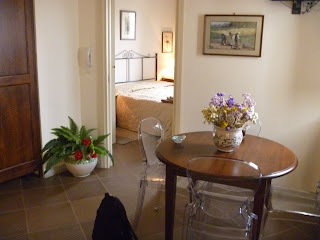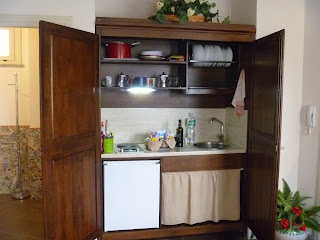To travel to Segesta from the north the road leaves the coast and turns inland. Dramatic, chiselled coastline becomes abundant, green, patchwork fields as far as the eye can see. Olives, vineyards, bright yellow canola, fields of tomatoes and green leafiness. The contrast between the coast and the food bowl of Sicily couldn't be greater.
To reach Erice, the town built on the summit of a mountain, we travel up, up, up, switching back and turning until we are driving through cloud. Massimo has arranged to meet us at the town car park where we leave Sophia. Massimo drives us further through the cloud, along tiny stone alleys, and around impossibly narrow bends until we reach the old stone house, now four apartments, one of which we have rented for three days.
This part of Sicily reveals Arab influences that endure from the two centuries when Arab dynasties ruled Sicily. We can see it in the architecture and the food - we're told it can also be found in words of the Sicilian language. We're staying in one of Erice's traditional courtyard homes. All over the town, behind big oaken doors, dwellings were built around stone courtyards. Today we've seen Muslim-like turrets which remind us of the tops of homes we stayed in in Morocco. In restaurants in Erice and neighbouring Trapani couscous with fish soup is a speciality - cooked in an earthenware pot it is delicate and delicious. I notice that the food seems a bit hotter and spicier than in mainland Italy (signore however continues to carry his personal supply of dried chillis). And everywhere almonds.... delicious morsels and sweets made from ground or chopped almonds. Oh, and did I mention the Sicilian cannoli? Delightful fine and crisp tubes of pastry, filled through with delicately-sweet creamed ricotta, garnished with a sliver of candied orange rind. Oh my! In the pasticcerias (such as Maria Grammatico's, just off the main square) the shells are left empty behind the counter and are filled as each one is purchased - the pasty remains crisp and fresh.
Back to Erice....
Apparently Erice, like Segesta, was built by the Elymian people who were fleeing from Troy - so that makes it very old indeed. The whole village is constructed of grey stone cut from the mountain on which it stands. There are more than 15 churches in this tiny village, a castle, a public garden, ancient walls and every winding, steep lane and alley is intricately cobble-stoned in the same design. There are only 300 inhabitants in Erice and they are easy to distinguish from the tourists like us who come to stay here in the clouds.
When the clouds part the view to Trapani, the sea, and the surrounding salt plains is glorious.
 |
| On the way up to Erice. |
 |
| When the clouds part, the view is majestic. |
 |
| Erice |
 |
| Erice |
 |
| Morning sun in the square, Erice. |
 |
| The courtyard behind the large timber front doors. |
 |
| Erice home for three days. |
 |
| Cucina....now you see it..... |
 |
| ...now you don't. Cute. |
 |
| The bathroom is tiled with fragments of the old tiled floors of the Erice house that Massimo renovated in 2006. |
 |
| Walking through the cloud. |
 |
| Behind doors just like this Erice homes have delightful courtyards, full of pots of colourful geranium, hydrangea and draping vine. |
 |
| Erice's distinctive cobblestone streets. Every street cobbled in this same design. |
 |
| Maria Grammatico's beautiful pasticceria and café (and her beautiful Mediterranean tiled floor). |
 |
| This is 1% of the population of Erice, buying their fish in the main square, from a fish monger who brings it up the mountain each morning. |
 |
| Sicilian salt mounds - the salt pans of Trapani (and Erice on top of the mountain). |
 |
| Sicilian wood-fired pizza is the best pizza in all of Italy! Delicately cut and served in small bite-sized squares. Buona. |


No comments:
Post a Comment